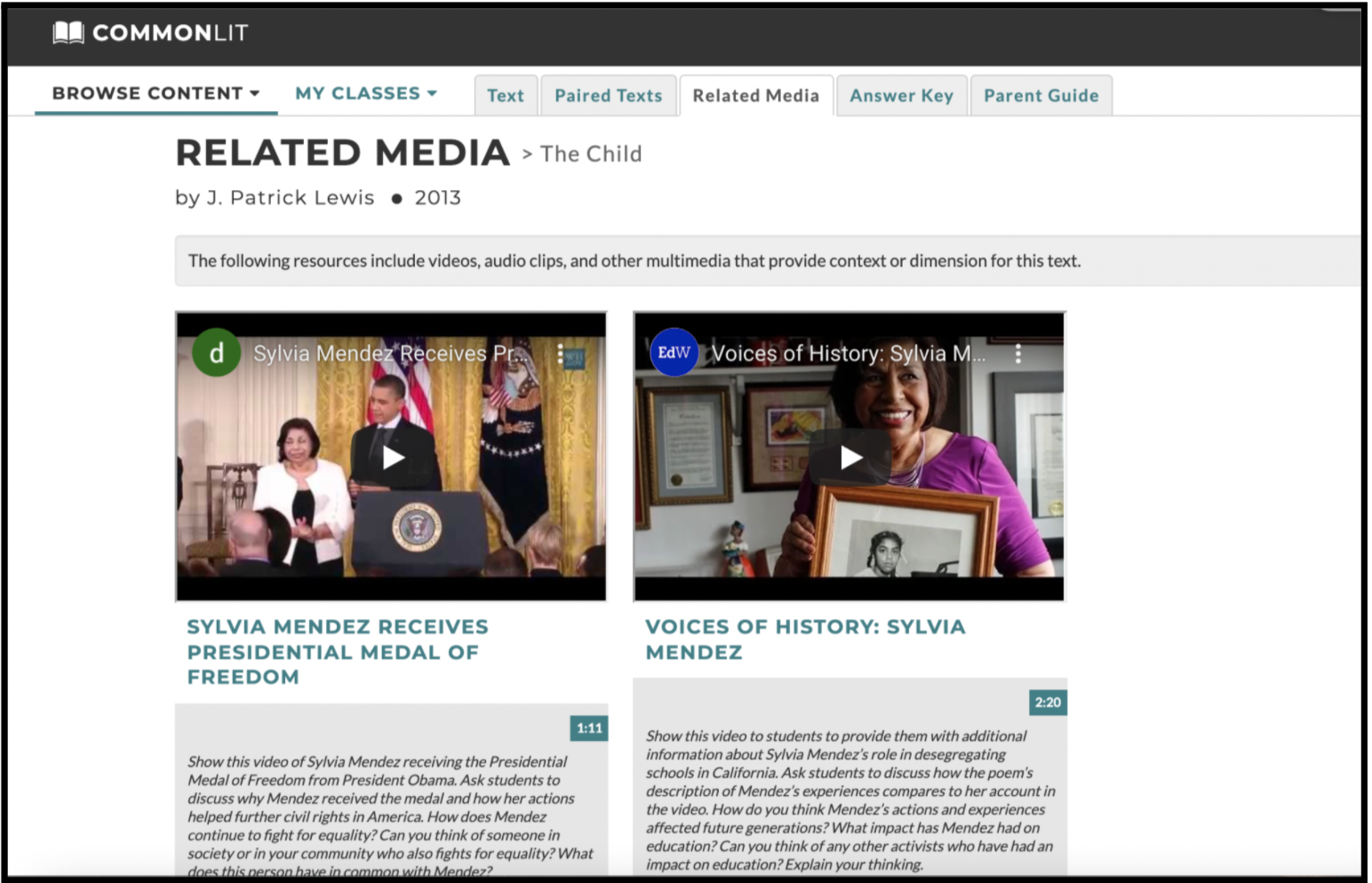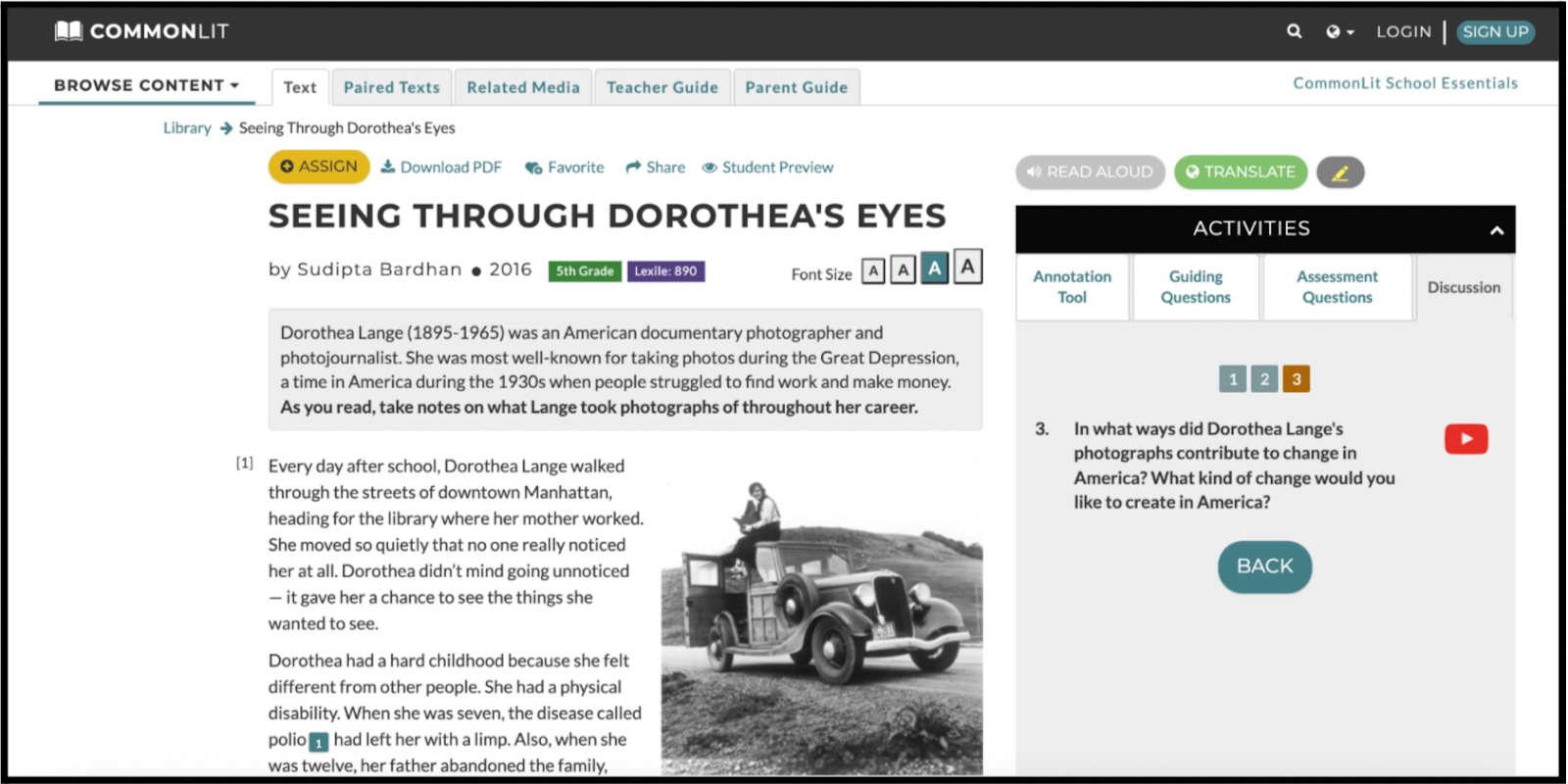These engaging texts about incredible women for grades 3–5 will inspire your students!
As teachers, we want to encourage all of our students to dream big. Reading about women who changed the world can help students gain confidence to face challenges in their own lives and inspire them to follow their dreams and passions.
Here is a meaningful selection of texts for grades 3–5 from CommonLit about influential women throughout history. These women who overcame obstacles, thought of new ideas, and advocated for others are sure to inspire your students!
“The Child” by J. Patrick Lewis (4th Grade)
In this compelling poem, Lewis describes the experiences of Sylvia Mendez, a Mexican-Puerto Rican civil rights advocate. The poem uses powerful metaphors to depict the glaring differences between the segregated elementary schools in town. Sylvia pictures the doors of the white school locked with secret combinations of frowns, but thinks she may have the key to get in.
Before reading, build students’ background knowledge by showing the video “Voices of History: Sylvia Mendez” under Related Media. Have students make text-to-text connections by discussing how the poem’s description of Mendez’s experience compares to her account in the video.

“Alice Coachman Jumps for the Sky” by Barbara Kramer (5th Grade)
In this informational text, the author describes athlete Alice Coachman’s life and accomplishments. As a child, Alice was a natural athlete, even though her parents wanted her to act like a lady. However, Alice was determined to compete. As a teenager, Alice broke both high school and college high jump records. Later, she became the first African American woman to win an Olympic gold medal.
This text could be paired with “Should Girls Be Allowed To Play High School Football?” which describes the debate over whether or not girls should be allowed to play football in an Alabama community. After reading both texts, students should discuss how women are treated in sports.
“Seeing Through Dorothea’s Eyes” by Sudipta Bardhan (5th Grade)
In this informational text, the author describes Dorothea Lange’s life and accomplishments. Lange was an influential photographer during the Great Depression. Her powerful images helped create meaningful change in the treatment of working class people.
After students read, have them discuss the significance of Lange’s contributions. Use Discussion Question 3, “In what ways did Dorothea Lange’s photographs contribute to change in America? What kind of change would you like to create in America?”

“Marian’s Revolution” by Sudipta Bardhan-Quallen (5th Grade)
Marian Anderson was a well-known African American singer in the 20th century, but her road to fame was far from easy. Despite her talent, she constantly faced racial oppression and segregation. Anderson did not let these obstacles stop her from following her dreams of becoming a singer, paving the way for other Black girls and women.
As students read, have them follow the annotation task, which asks them to take notes on how Marian responded to the obstacles she faced during her career. Then, have students use their notes to discuss how Marian overcame these obstacles.
“African American Suffragists” by Margaret Gushue (5th Grade)
In the United States, women did not have the right to vote until the 1920s. The women who fought tirelessly for this right were known as suffragists. African American women faced a unique challenge. Not only were they ostracized by men, they were also excluded from the suffragist movement by white women. Nevertheless, African American women continued to lead the fight for women’s right to vote.
After reading, have students make text-to-self connections. Ask Discussion Question 2, “In the text, the author compares women not being allowed to vote to being ignored in the classroom. Describe a time when you felt deliberately ignored or silenced. How did it make you feel? How do you think African American women felt when they were disregarded by men and white women?”
“A Princess Who Can Tune an Engine” by Rosi Hollinbeck (4th Grade)
In this text, the author describes how Queen Elizabeth II was not always a dainty princess. During WWII, she became a mechanic through the Auxiliary Territorial Service (A.T.S.), a female branch of the British military. In this role, Elizabeth gained confidence and maturity, which helped her to inspire other children during the war.
After students read, watch “The Queen As a Mechanic (1945)” under the Related Media tab to show students footage of the young Queen working on a car during an A.T.S. training. Ask students to share how they think the footage of Elizabeth taking part of the training impacted her public image.
“Dolores Huerta, Leader and Activist” by Diane L. Brooks (5th Grade)
Dolores Huerta is remembered as one of the “100 Most Important Women of the 20th Century” for her work as an American labor leader and civil rights activist. In this informational text, the author discusses Huerta’s journey to become the founder of the National Farm Workers Association and an important civil rights activist for immigrant farm workers.
Huerta was an important leader to whom students can look up to. Ask students Discussion Question 3, “In the text, Dolores Huerta is described as a leader in the movement to improve workers’ rights. How did she become a leader? What qualities do you think a leader needs in order to create positive change?” Have students make connections to other leaders they have learned about.
“Girls of the Crescent” by Girls of the Crescent (5th Grade)
In this article, two teenagers describe how they fought for meaningful change in their community. Mena and Zena are both Muslim and never saw themselves represented in literature. The girls decided to start their own non-profit organization that collects books with female Muslim characters and distributes them to schools and libraries around the country.
This text could be paired with “Malala Yousafzai: A Normal Yet Powerful Girl,” which describes the life and accomplishments of the youngest winner of the Nobel Peace Prize. After reading both texts, ask students why the girls were inspired to make changes in their communities.
“The Girl Who Listened With Her Feet” by Eve Nadel Catarevas (5th Grade)
In this informational text, the author describes how Laura Bridgman became the first deaf-blind person to learn how to read and write. Bridgman worked hard to learn how to communicate with her hands and feet. Her journey paved the way for other children with disabilities to communicate their own ideas and receive an education.
Consider assigning CommonLit’s Guided Reading Mode to your students while they read. Answering the Guiding Questions will help students better grasp how Bridgman learned to use her senses to communicate.
Next Steps
Looking for more texts to celebrate the achievements of amazing women? Check out CommonLit's Target Lessons About Courageous Women!
If you’re interested in learning all about CommonLit’s free digital literacy program, join one of our upcoming webinars!


